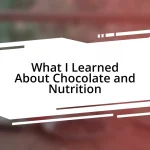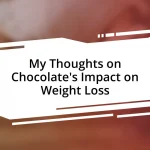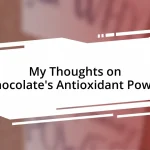Key takeaways:
- Vegan chocolate desserts can be as indulgent as traditional ones, utilizing unique ingredients like avocado and chia seeds for creamy textures.
- Choosing high-quality ingredients, including organic cacao and appropriate sweeteners, is essential for enhancing the flavor of vegan chocolate desserts.
- Experimenting with textures through ingredients like aquafaba and coconut oil can transform the mouthfeel of desserts, making them more enjoyable.
- Flavor pairing with contrasting ingredients like fruits or spices can elevate the overall experience of vegan chocolate dishes.

Exploring vegan chocolate options
When I first dove into the world of vegan chocolate desserts, I was pleasantly surprised by the variety available. There’s something magical about finding bars made with rich cacao and sweetened with natural ingredients like maple syrup or coconut sugar. Have you ever tasted a dark chocolate that didn’t use dairy and still left you craving more? It’s definitely a game changer.
I remember stumbling upon a local bakery that specialized in vegan options. One bite of their salted caramel chocolate tart had me convinced that plant-based desserts could be just as indulgent as traditional ones. I still think about that tart; it wasn’t just dessert—it was an experience that reshaped my views on vegan treats.
Exploring different brands and homemade recipes, I discovered unique ingredients like avocado and chia seeds that create unbelievably creamy textures in mousse and puddings. It’s fascinating to witness how these healthy substitutes can elevate a dessert’s flavor profile. Isn’t it amazing how experimenting in the kitchen can lead to such delightful surprises?

Choosing the right ingredients
When it comes to choosing the right ingredients for vegan chocolate desserts, it’s all about balance and flavor. I’ve found that high-quality cacao is non-negotiable. For me, opting for organic cacao powder or dark chocolate means rich taste without unwanted additives. Have you ever tasted a vegan dessert that just fell flat? I have, and it often boiled down to subpar chocolate.
Sweeteners can also make or break your dessert. I once substituted sugar with agave nectar in a brownie recipe, hoping to achieve a richer sweetness. To my surprise, the brownies were gooey but lacked the sweetness I craved. That experience taught me how important it is to carefully select sweeteners that complement the chocolate, enhancing its natural flavors rather than masking them.
Don’t overlook the impact of textures and consistencies in your ingredients. For instance, I love using almond milk instead of regular milk—it adds a subtle nuttiness that complements chocolate beautifully. After experimenting with various plant-based milks, I’ve settled on oat milk for its creaminess. What kind of textures do you look for in vegan desserts? Finding the right combination can transform a simple recipe into a luxurious treat.
| Ingredient | Notes |
|---|---|
| Organic Cacao Powder | Rich flavor, no additives |
| Coconut Sugar | Low GI, natural sweetness |
| Agave Nectar | Substitutable sweetener, but adjust quantity |
| Almond Milk | Nuttiness complements chocolate |
| Oat Milk | Creme-based texture, great for desserts |

Recipes for vegan chocolate desserts
When I started experimenting with recipes for vegan chocolate desserts, I quickly learned that a few key creations could easily satisfy any chocolate craving. One of my absolute favorites is vegan chocolate mousse made with silken tofu and melted dark chocolate. It’s hard to believe that something so creamy and decadent can come from tofu, right? A friend of mine was skeptical at first, but after tasting it, they were convinced, asking for the recipe to impress their family!
Here are a few recipes that I recommend trying:
- Vegan Brownies: Made with black beans, cacao powder, and maple syrup for sweetness—deliciously fudgy!
- Chocolate Avocado Pudding: Just blend ripe avocados with cocoa powder, almond milk, and a bit of agave nectar for a quick treat.
- Raw Chocolate Energy Balls: Combine dates, nuts, cocoa powder, and a touch of vanilla; they’re perfect for when you need a pick-me-up.
- Vegan Chocolate Cake: Use almond milk, coconut oil, and apple cider vinegar for a moist and fluffy cake that everyone will love.
- Chocolate Chia Seed Pudding: Mix soaked chia seeds with almond milk and cocoa powder, let it sit overnight, and enjoy a healthy, indulgent breakfast.
I remember making the chocolate energy balls for a gathering once and watching my friends devour them—they were shocked when I revealed they were vegan! It felt great to share something so rich in flavor while also being healthy. I love the way these recipes come together, combining simplicity with creative flair. What’s been your go-to recipe so far?

Tips for perfecting texture
Perfecting the texture of vegan chocolate desserts often boils down to the ingredients you choose. For instance, I had a revelation when I started incorporating aquafaba, the liquid from canned chickpeas. Whipping it up creates a light, airy texture that’s perfect for mousses or cakes, making me wonder why I hadn’t tried it sooner! Have you ever considered using this versatile ingredient? It’s a game changer.
Another tip is to be mindful of the fats you use. I once substituted traditional oils in my chocolate recipes with coconut oil, thinking it would give a tropical twist. The result? A beautiful, glossy finish and a melt-in-your-mouth consistency that left me speechless. It’s amazing how something as simple as oil can shift the entire mouthfeel of a dessert. What types of fats have you found to elevate your desserts?
Lastly, pay attention to baking times and temperatures. I recall making a batch of vegan brownies where I pulled them out too soon, thinking they looked done. They turned out too soft and pudding-like, which wasn’t the texture I was aiming for. Ever had that moment when you just couldn’t wait? That experience taught me to trust my senses and let things cool properly before slicing. Perfecting texture is often about trial and error, but each misstep can lead to delicious discoveries.

Pairing flavors with vegan chocolate
When it comes to pairing flavors with vegan chocolate, the possibilities are genuinely exciting. I find that contrasting flavors often enhance the rich taste of chocolate. For example, the tartness of raspberries or the brightness of orange zest can create a beautiful harmony. I remember making a chocolate raspberry tart once for a friend’s birthday; the vibrant flavors danced together, and it sparked a lively discussion at the dinner table!
Herbs and spices are another exciting avenue to explore. I love infusing my vegan chocolate with hints of rosemary or sea salt for an unexpected twist. Once, I added a sprinkle of cinnamon to melted dark chocolate as a dip for fruit. The combination was a delightful surprise, awakening all the taste buds! Have you thought about which spices might elevate your favorite chocolate desserts?
Don’t overlook the role of textures in flavor pairing, either. The crunch of toasted nuts against the smoothness of chocolate creates layers of experience. I once whipped up a chocolate bark topped with pistachios and sea salt, and I can still hear my friends raving about it. It’s magnificent how a simple ingredient, like a nut or a sprinkle of salt, can transform the entire dessert. What unique flavors or textures have you paired with chocolate that truly wowed you?














